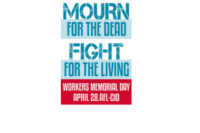Whether it’s called Workers' Memorial Day, International Workers' Memorial Day or International Commemoration Day (ICD) for Dead and Injured or Day of Mourning, April 28 will be dedicated – in all corners of the globe - to remembering workers who’ve killed, disabled, injured or sickened by their work.
Its slogan, Remember the dead – Fight for the living, is derived from a quote attributed to early labor organizer Mary Harris “Mother" Jones, who famously said: “Pray for the dead, and fight like hell for the living.” The diminutive yet ferocious Jones did, in fact, “fight like hell” for workers – especially coal miners – and her battles with powerful corporate titans and political figures got her repeatedly arrested and jailed.
The slogan moves the day beyond remembrance toward action on making workplaces safer and preventing accidents and work-related illnesses.
The AFL-CIO founded Workers Memorial Day in 1970 – the same year the Occupational Safety and Health Act was passed by the U.S. Congress. Organizations in other countries followed suit, sometimes with different names. April 28, for instance, is recognized by the International Labour Organisation (ILO) and the International Trade Union Confederation (ITUC) as International Workers' Memorial Day. The UN recognizes April 28 as World Day for Safety and Health at Work.
Along with the U.S. and the UK, Workers' Memorial Day is recognized as a national day in: Australia, Argentina, Belgium, Bermuda, Brazil, Canada, Dominican Republic, Gibraltar, Ireland, Luxembourg, Panama, Peru, Portugal, Spain, Thailand, Taiwan. Trade unions in other countries including Benin, Czech Republic, Finland, Hungary, Malta, Nepal, New Zealand, Romania and Singapore are lobbying their governments for recognition of the day as well.
Workers' Memorial Day events are held throughout the world and include candlelight ceremonies, the reading of names of the deceased, stage plays about the labor movement, workplace safety awareness events, speeches by public officials, religious services, the laying of wreaths, the unveiling of monuments, balloon releases and setting out empty shoes to symbolize those who have died at work.
- Click here to see the AFL-CIO’s list of events.
- Click here to see OSHA’s list of events.


